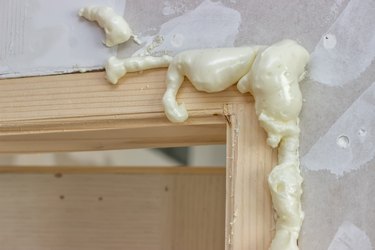Removing spray foam insulation is a daunting task that few look forward to tackling. It's a difficult substance that doesn't leave people with many options when it comes to removing it. For clothes and skin, it's always best to act quickly before it dries as it becomes much more difficult when the insulation has hardened. The opposite is true, however, when it comes to removing it from common building materials.

Video of the Day
Removal From Construction Materials
The first thing to do when considering spray foam insulation removal is to purchase a mask. It's important to keep the nose and mouth covered at all times due to dust residue. When it's time to begin taking away the foam insulation, make sure that it's completely dry to make removal easier.
Video of the Day
Begin the process by cutting out pieces of the insulation with a knife, saw or even a flat pry bar and hammer. Take out as much as possible with any of these tools, and just keep an eye out for any wiring that could be hidden within the spray foam so you don't take out the wires as well. The spray foam insulation that remains should be scratched with either a hard bristle brush or a paint scraper to get as close to the wood, concrete or brick as possible.
Finally, to remove the last traces of spray foam insulation, apply lacquer thinner to the foam and wipe away with a rag once the foam has loosened its hold from the material. Never use water to remove spray foam insulation as it has a counter effect and hardens the foam instead of softening it.
Removal From Clothing
It's best to remove spray foam insulation from clothing when it's still wet and hasn't had time to set. Rub down the exposed clothing with a dry rag that you don't mind throwing out later, and take off all the insulation that came into contact with the fabric. The next step is key in erasing all evidence of the foam from the clothing. Dampen a rag with acetone, which can be found in nail polish remover, and blot it on the areas where the insulation was in contact with the material. Follow this with a treatment of clothing stain remover and wash the clothes according to the directions on the stain remover bottle.
If the spray foam insulation has set and is too hard to wipe off, try breaking it off in chunks and then continue the above process from the acetone-blotting step. This is definitely a more difficult alternative and can be avoided altogether by wearing a disposable jumpsuit over your clothing or wearing old clothes that you don't mind throwing away when working with spray foam insulation.
Removal From Skin
The most common area of skin to be affected by spray foam insulation is the hands. Like with clothing, it's easiest to deal with the foam immediately when it's still wet. The process is fairly similar to the removal from clothing, except with an added treatment for your hands since they might take a beating from the insulation.
Begin by wiping the skin with a rag and removing all the wet foam. Follow up by moistening a rag with acetone and rubbing it all over the skin, making sure that no areas of affected skin are missed. This should remove all the insulation. Finish the process by generously applying lotion to your hands to keep them moist and hydrated.
If the foam has hardened, removal from skin becomes a bit more tedious and frustrating. Take a pumice stone and use it to scrub the areas of dried foam until there's no more sign of insulation. Treat the affected areas with petroleum jelly and cover the hands in gloves long enough to let the jelly soak in and nourish the skin. Remove the gloves after about 60 minutes, and wash hands with soap and water. This treatment should restore your hands and have them ready for another DIY project in no time.